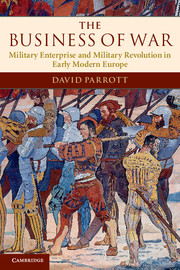Book contents
- Frontmatter
- Contents
- Figures
- Maps
- Acknowledgements
- Abbreviations
- Currencies
- Introduction
- Part I Foundations and expansion
- 1 Military resources for hire, 1450–1560
- 2 The expansion of military enterprise, 1560–1620
- 3 Diversity and adaptation: military enterprise during the Thirty Years War
- Part II Operations and structures
- Notes
- Bibliography
- Index
2 - The expansion of military enterprise, 1560–1620
Published online by Cambridge University Press: 05 January 2015
- Frontmatter
- Contents
- Figures
- Maps
- Acknowledgements
- Abbreviations
- Currencies
- Introduction
- Part I Foundations and expansion
- 1 Military resources for hire, 1450–1560
- 2 The expansion of military enterprise, 1560–1620
- 3 Diversity and adaptation: military enterprise during the Thirty Years War
- Part II Operations and structures
- Notes
- Bibliography
- Index
Summary
As troops across western Europe dispersed into winter quarters, ports and garrisons in late 1555, the fifth continuous campaign fought between the Emperor Charles V and his rival, Henri II of France, came to an inconclusive end. Both rulers and their governments were well aware of the fiscal stresses that this uninterrupted warfare was generating. In 1553 French military expenses, not including fortification works, were conservatively estimated at 13.2 million livres, and with similar expenditure in prospect for each successive year of war, it was impossible to meet military expenses without a dramatic increase in borrowing. In 1555 the French crown sought to reorganize its financial dealing through what became known as the Grand Parti, based on a consortium of Lyon-based bankers who raised the ever-larger sums required by the crown via the international financial community which transacted business at the three-monthly Lyon money fairs. Charles V and his son Philip were no less aware of the fiscal pressures of warfare. In February 1555 it was estimated that more than a million ducats would be required simply to maintain Spain’s defensive positions on the frontiers of the Milanese, while a serious offensive would cost vastly more. The situation in the Netherlands was even worse, with a state debt of 7 million florins by the end of 1555, and an annual deficit of 3 million ducats.
The traditional instinct of rulers in this situation was to look for a peace settlement that would preserve reputation but would allow for the drastic curtailment of borrowing and some consolidation of existing debts. This had been the case after the last round of the Habsburg–Valois struggle, fought from 1542 down to the 1544 Peace of Crépy. The negotiation of the truce of Vaucelles in February 1556 came as no great surprise therefore; but its collapse later in the year, as the new Carafa pope, Paul IV, provoked a conflict with the Spanish over control of Naples and drew the French back into Italy to provide military support, was an alarming new development. War broke out again in northern France and was to reach its climax in August 1557 with the crushing French defeat at St Quentin.
- Type
- Chapter
- Information
- The Business of WarMilitary Enterprise and Military Revolution in Early Modern Europe, pp. 71 - 100Publisher: Cambridge University PressPrint publication year: 2012



